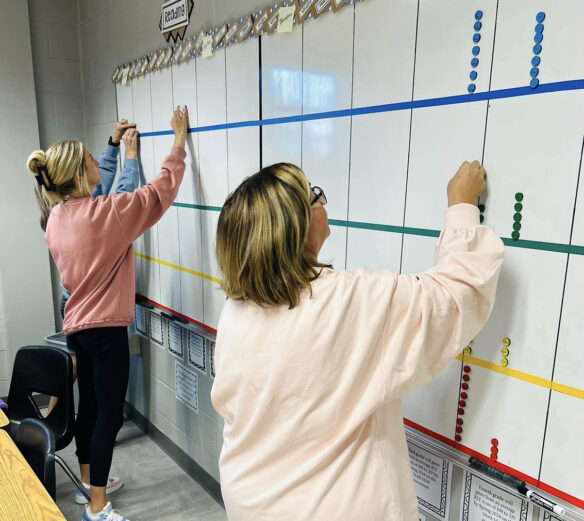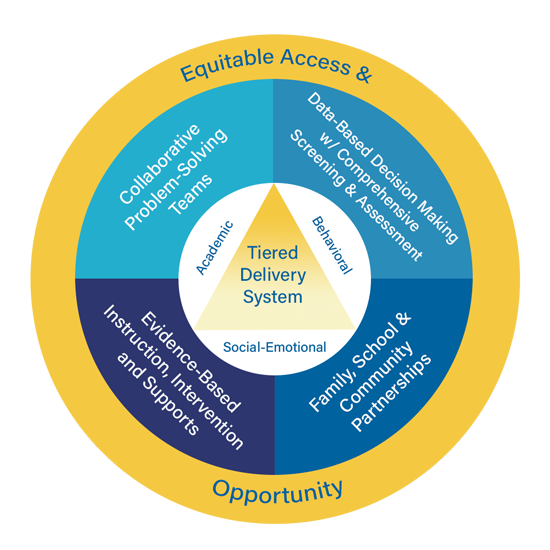
Staff in Daviess County have been working on implementing a multi-tiered system of supports (MTSS) for the last three years.
Submitted photo
Editor’s note: This story is part of a series on Kentucky’s Multi-Tiered System of Supports (MTSS) and districts that are in the process of implementing their own MTSS.
Leslie Peveler, director of elementary schools and the multi-tiered system of supports (MTSS) coordinator in Daviess County, said year three of implementing the district’s MTSS is starting strong.
“I think it’s had a swifter pace this year than what we’ve seen in years past,” she said.
MTSS is an effort to support student achievement and social-emotional behavioral competencies through the integration of core instruction, assessment and intervention.
The vision of the Kentucky Department of Education (KDE) and the goal of an integrated MTSS is “each and every student empowered and equipped to pursue a successful future.”
The Kentucky framework of the multi-tiered system of supports (KyMTSS) is surrounded by equitable access and opportunity showing this essential element should be a consideration in every other aspect of the system.
At the center of the model is a triangle representing the tiered delivery system, designed to meet the academic, behavioral and social-emotional needs of all students.

The KyMTSS model
“The first year we really focused on training for our staff (for) the basic understanding of what MTSS means within a school and within a classroom,” said Peveler. “We moved from that sense of ensuring everybody had the basic knowledge, whether that was vocabulary or understanding.”
Working alongside Peveler is Caleb York, assistant superintendent for human services in Daviess County. He said the first year was about clarification and setting the expectations for MTSS and year two was about application.
By trying new initiatives and new changes to incorporate MTSS tactics, York said “I think in education, we’re great at adding all these new acronyms that a lot of times we try to take that new round peg and fit it into the old square hole and in year two, that’s what it felt like we were doing.”
In year three of implementation, however, things started to click.
“Staff members suddenly are starting to celebrate this feeling that our classroom teachers are owning what it is that they want to do for kids,” said Peveler. “They’re utilizing data to make really good, strong, collaborative relationships with one another so that we look at a kid with the whole picture.”
In addition to the application and changes within the classroom, Peveler said, “It was really about refining and ensuring that we were all understanding MTSS correctly.”
Peveler said as they continue through this learning process, they want to make sure their teachers and educators never lose their authenticity and autonomy in their classrooms, but she also said, “at the same time we want it to get very systematic in what was expected within a school in order to make gains in the places that we needed to.”
York said some of the gains they were looking to make as a school fell within different areas like mental health, Positive Behavioral Interventions and Supports, and co-teaching.
“MTSS kind of became that middle cog that makes them all kind of work together and that’s what I’ve really started to see from everything, from what happens in the classroom to classroom supports,” she said.
Peveler said now that the district is in its third year with MTSS, the systems and supports are beginning to consistently get put into play. She said, “Educators are paying close attention to the data that is coming through and focusing on how their systems were working or essentially not working.”
“I think our teachers are beginning to truly wrap their minds around the fact that they are the first interventionists that children encounter within that classroom and the four walls of what they’re doing,” said Peveler. “It’s vital for our teachers to know how to intervene appropriately and have the appropriate data to make good decisions.”
Three tiers are typically used in KyMTSS to describe the level and intensity of practices across the continuum. Movement through the tiers is a flexible and fluid process based on formative student assessment data and collaborative team decisions. Tier 1 is the foundational or universal level of support. All students receive high-quality, evidence-based instruction aligned to grade-level standards, schoolwide behavioral expectations and key social-emotional competencies. In sustainable systems, at least 80% of students have their needs met through this universal level of support.
Tier 2 is the targeted or supplemental level of support. Intended for some students who require more opportunities for practice and feedback or enrichment beyond Tier 1. In sustainable systems, 10-15% of students access this level of support in addition to the universal level. Tier 2 supports are often provided to groups of students with similar targeted needs.
Tier 3 is the most intensive level of support. It is intended for students with the most significant and persistent needs extending well beyond the reach of the Tier 1 level. In effective systems, 3-5% of students need access to this level of support. Tier 3 is characterized by increased intensity and individualization of instruction and targeted support.
York said the district is finding success with Tier 2 interventions that in the past have needed Tier 3 supports to be able to find any level of success or support inside of the classroom or inside of the school.
Peveler and York said they understand implementing MTSS will continue to be a journey, but they are excited to start seeing their students’ progress, both inside and outside of the classroom.



Leave A Comment